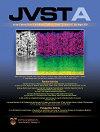Molecular dynamics simulation of amine formation in plasma-enhanced chemical vapor deposition with hydrocarbon and amino radicals
IF 2.1
3区 材料科学
Q3 MATERIALS SCIENCE, COATINGS & FILMS
引用次数: 0
Abstract
Molecular dynamics simulations were performed to examine the amine formation in carbon-based polymer films deposited by plasma-enhanced chemical vapor deposition (PECVD) with methane (CH4) and nitrogen (N2) gases. In the simulations, the interactions between the deposited film surface and incident precursors were examined, where nitrogen species were assumed to be supplied only as amino radicals (NH2) such that the amount of primary amine (−NH2) could be maximized in the deposited film. Carbon was supplied as CH2 or CH3 radicals as well as CH2+ or CH3+ ions with an ion kinetic energy up to 100 eV, as typical in such PECVD experiments. It has been found that, even under such “ideal” conditions for the maximum primary-amine content, hydrogen (H) atoms of incident NH2 radicals tend to be transferred to surrounding C atoms in the polymerization process, leaving a relatively small amount of primary amine (the concentration ratio of primary amino groups NH2 to nitrogen atoms N ∼10%) in the deposited polymer films. The simulation results indicate that an increase of NH2 radicals in the gas phase of PECVD hardly increases the primary-amine content in the deposited films and, therefore, the primary-amine content may not depend strongly on the plasma conditions as long as a sufficient amount of nitrogen and hydrogen is supplied during the plasma polymerization process. The primary-amine content predicted by the simulations was found to be consistent with earlier experimental observations.等离子体增强烃类和氨基自由基化学气相沉积中胺形成的分子动力学模拟
通过分子动力学模拟研究了等离子体增强化学气相沉积(PECVD)技术沉积碳基聚合物薄膜中胺的形成过程。在模拟中,研究了沉积膜表面与入射前驱体之间的相互作用,其中氮种假设仅以氨基自由基(NH2)的形式提供,从而使沉积膜中伯胺(- NH2)的量最大化。碳作为CH2或CH3自由基以及CH2+或CH3+离子提供,离子动能高达100 eV,这在PECVD实验中是典型的。研究发现,即使在这种最大伯胺含量的“理想”条件下,在聚合过程中,入射NH2自由基的氢(H)原子也倾向于转移到周围的C原子上,从而在沉积的聚合物薄膜中留下相对少量的伯胺(伯氨基NH2与氮原子的浓度比N ~ 10%)。模拟结果表明,PECVD气相中NH2自由基的增加几乎不会增加沉积膜中伯胺的含量,因此,只要在等离子体聚合过程中提供足够的氮和氢,伯胺含量可能不强烈依赖于等离子体条件。模拟所得的伯胺含量与早期的实验结果一致。
本文章由计算机程序翻译,如有差异,请以英文原文为准。
求助全文
约1分钟内获得全文
求助全文
来源期刊

Journal of Vacuum Science & Technology A
工程技术-材料科学:膜
CiteScore
5.10
自引率
10.30%
发文量
247
审稿时长
2.1 months
期刊介绍:
Journal of Vacuum Science & Technology A publishes reports of original research, letters, and review articles that focus on fundamental scientific understanding of interfaces, surfaces, plasmas and thin films and on using this understanding to advance the state-of-the-art in various technological applications.
 求助内容:
求助内容: 应助结果提醒方式:
应助结果提醒方式:


